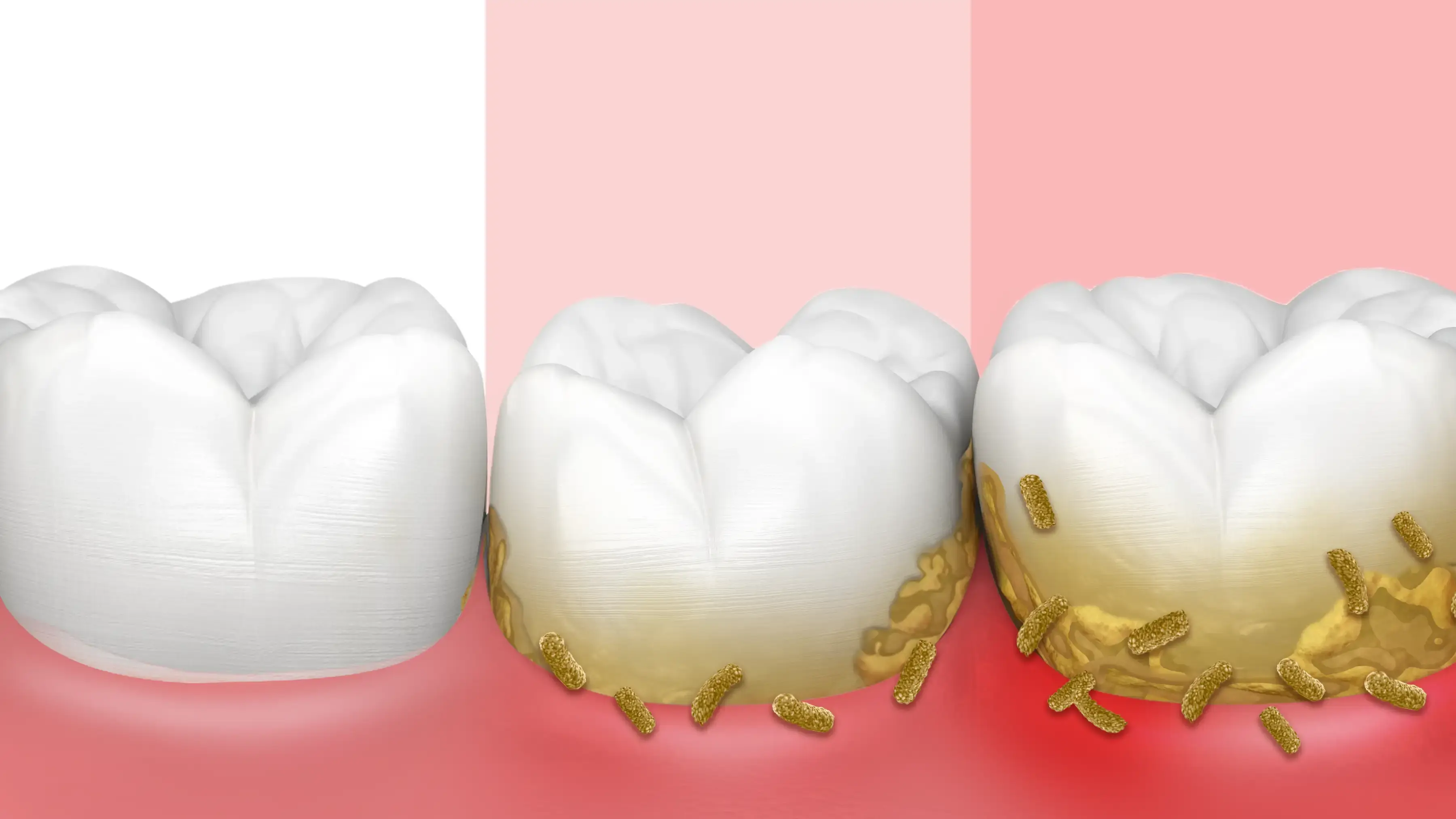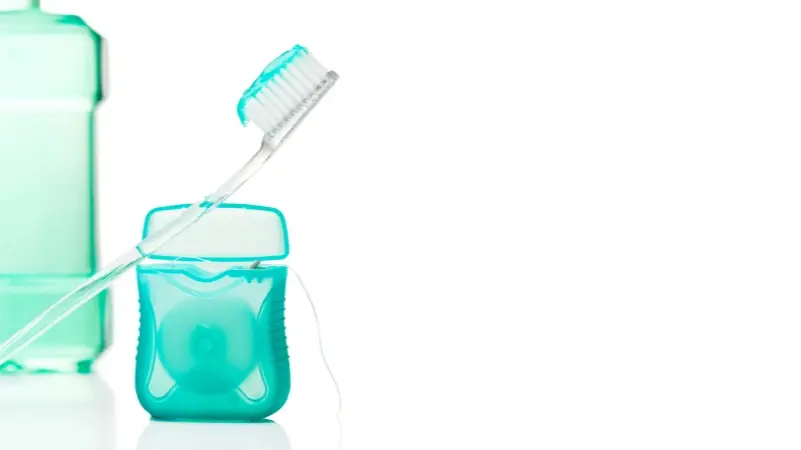Inflamed gums. The silent signal that often speaks volumes about our oral health. We may not give much thought to our gums until they decide to voice their discomfort, whether through swelling, tenderness, or even bleeding. But behind this seemingly minor irritation lies a deeper story, one intertwined with the complex realm of gum disease. Far more than just an inconvenience, inflamed gums serve as a red flag, signaling gum disease as a result of potential issues with our oral hygiene habits or underlying health conditions.1 Overlooking regular oral hygiene habits, alongside factors like bacterial buildup or systemic diseases are in fact among many of the reasons that can contribute to the characteristic puffiness and inflammation of our gums.2
Why Are My Gums Inflamed?
Gingivitis and Inflamed Gums
Gingivitis, the early stage of gum disease, is a common culprit behind inflamed, red, or inflamed gums. It occurs when plaque, a sticky film of bacteria, builds up along the gumline, triggering an immune response that leads to gum irritation and inflammation.3
As gingivitis progresses, gums may bleed easily, signaling a worsening condition that can eventually lead to more severe forms of gum disease if left untreated.2,4
Brushing Your Teeth Too Hard
Believe it or not, brushing your teeth too vigorously can actually do more harm than good, especially when it comes to your gums. While it's important to brush thoroughly to remove plaque and debris, aggressive brushing can damage delicate gum tissue.5 The excessive pressure can wear down the enamel on your teeth and cause the gums to recede, exposing the sensitive dentin.5
Tooth Decay
Tooth decay, also referred to as dental caries or cavities, can contribute to gum inflammation, redness, and swelling. When bacteria in the mouth feed on sugars from food, they produce acids that erode tooth enamel, leading to cavity formation. As decay advances, it may cause inflammation and tenderness in surrounding gums, especially if the infection spreads to adjacent gum tissue.
Additionally, untreated tooth decay can result in the development of a dental abscess, a pocket of pus caused by bacterial infection in the tooth or gums. This abscess can cause significant pain, swelling, and inflammation of surrounding gum tissue. This is a dental emergency that requires professional treatment.6,7,8
Hormones and Gum Inflammation
Hormonal fluctuations, such as those experienced during puberty, pregnancy, menstruation, or menopause, can impact gum health and contribute to inflammation. Changes in hormone levels can render gums more susceptible to inflammation.2
During puberty, hormonal shifts may heighten the body's response to plaque, elevating the risk of gingivitis and gum inflammation. Pregnancy gingivitis, characterized by inflamed and gums, is a prevalent condition among expectant mothers due to hormonal fluctuations. Similarly, hormonal changes during menstruation and menopause may exacerbate gum inflammation in some individuals.9,10
Inflamed Gums and Medications
Certain medications may cause gingival enlargement as a side effect.11 These medications can lead to an exaggerated inflammatory reaction in the gums to plaque.12,13 If you have concerns about the interference between certain medications you are taking and your gum health, you should consult with your doctor or dentist.
Poorly Fitted Dental Appliances
Poorly fitted dental appliances, such as dentures, braces, or dental bridges, can contribute to gum irritation and inflammation.2, 14 When these appliances do not fit properly, they may rub against the gums, causing friction and pressure that can lead to soreness, redness, and swelling. Additionally, ill-fitting appliances may create spaces where food particles and bacteria can accumulate, increasing the risk of gum infection and inflammation. Over time, the constant irritation from the appliances can damage the gum tissue and compromise its health.14,15
Other Oral Infections Risks
Aside from gingivitis and periodontitis, other oral infections, such as gum abscesses, periodontal infections and viral infections like oral herpes, can result in notable swelling, tenderness, and inflammation of the gums.3,16 These infections typically arise when bacteria infiltrates the gum tissue, often due to untreated gum disease, inadequate oral hygiene practices, or weakened immune defenses. Additionally, viral infections can exacerbate gum irritation and inflammation, further compromising oral health.3
Lodged Food Debris
Trapped food debris lodged between teeth or along the gumline has the potential to provoke gum irritation and subsequent inflammation.17 When food particles become ensnared in interdental spaces or gum pockets, they create an ideal environment for bacterial proliferation. These bacteria generate acids and toxins that aggravate the gum tissue, resulting in redness and inflammation.3 Failure to promptly eliminate this debris through adequate brushing and flossing may foster the formation of plaque, intensifying gum inflammation and heightening the risk of gum disease.17
How to Treat or Prevent Inflamed Gums
Gently Brush and Floss Teeth
Gently brushing and flossing teeth are essential components of an effective oral hygiene routine, crucial for preventing gum inflammation and maintaining optimal gum health. It's important to brush with a soft-bristled toothbrush for at least two minutes twice a day, ensuring thorough coverage of all areas of the mouth.5,18
When it comes to flossing, it's essential to use proper technique to remove plaque and debris from between the teeth. Begin by pulling out a length of dental floss and wrapping it around your fingers, leaving a small section to work with. Gently guide the floss between each tooth, curving it into a C-shape around the base of the tooth and moving it up and down to remove plaque and debris. Be sure to floss between every tooth, including the back teeth, and avoid snapping the floss against the gums.19
Rinse with LISTERINE® Mouthwash Twice Daily
For optimal gum health benefits, consider incorporating LISTERINE® Clinical Solutions Gum Health Antiseptic mouthwash into your oral care regimen. This specialized formula is specifically formulated to target and address gingivitis, a prevalent cause of gum inflammation. LISTERINE® Clinical Solutions Gum Health Antiseptic mouthwash is used for three times healthier gums in one week versus brushing alone.
In fact, rinsing with LISTERINE® Mouthwash twice daily is a crucial step in the 3-step oral care routine that can significantly contribute to preventing gum inflammation.2,3 LISTERINE® mouthwash effectively kills 99.9% of bacteria that cause plaque formation, thereby reducing the risk of gum disease and inflammation. By including LISTERINE® in your daily oral hygiene routine, you can ensure a thorough cleanse that targets areas overlooked by brushing and flossing alone, promoting optimal gum health.20
Visit Your Dentist Regularly
Regular visits to your dentist are essential for maintaining optimal gum health and preventing inflammation. During dental check-ups, your dentist can assess the condition of your gums, identify any signs of inflammation or gum disease, and administer timely treatment or intervention as needed. Professional dental cleanings performed during these visits can effectively remove plaque, which is a common contributor to gum inflammation, thereby promoting healthy gums and preventing gum disease.
Moreover, routine dental appointments offer an opportunity for your dentist to provide personalized guidance on oral hygiene practices and lifestyle habits that can bolster gum health. By scheduling regular check-ups, you can take a proactive approach to your oral health, addressing any issues promptly and ensuring healthy gums and a radiant smile.21
References
Why Do I Have Swollen Gums? Cleveland Clinic. Accessed May 31, 2024. https://my.clevelandclinic.org/health/diseases/24907-swollen-gums
Singh B. Gingivitis – A silent Disease. IOSR Journal of Dental and Medical Sciences. 2013;6:30-33. doi:10.9790/0853-0653033
Cope G, Cope A. Gingivitis: symptoms, causes and treatment. Dental Nursing. 2011;7:436-439. doi:10.12968/denn.2011.7.8.436
Gingivitis: Symptoms & How To Treat It. Cleveland Clinic. Accessed May 31, 2024. https://my.clevelandclinic.org/health/diseases/10950-gingivitis-and-periodontal-disease-gum-disease
Pindobilowo, Tjiptoningsih UG, Ariani D. Effective Tooth Brushing Techniques Based on Periodontal Tissue Conditions : A Narrative Review. Formosa Journal of Applied Sciences. 2023;2(7):1649-1662. doi:10.55927/fjas.v2i7.4838
Douglass AB, Douglass JM. Common Dental Emergencies. afp. 2003;67(3):511-517.
Nguyen DH, Martin JT. Common Dental Infections in the Primary Care Setting. afp. 2008;77(6):797-802.
Dental abscess. nhs.uk. Published October 18, 2017. Accessed June 1, 2024. https://www.nhs.uk/conditions/dental-abscess/
Boyapati R, Cherukuri SA, Bodduru R, Kiranmaye A. Influence of Female Sex Hormones in Different Stages of Women on Periodontium. J Midlife Health. 2021;12(4):263-266. doi:10.4103/jmh.jmh_142_21
Markou E, Eleana B, Lazaros T, Antonios K. The Influence of Sex Steroid Hormones on Gingiva of Women. Open Dent J. 2009;3:114-119. doi:10.2174/1874210600903010114
Ciancio SG. Medications’ impact on oral health. J Am Dent Assoc. 2004;135(10):1440-1448; quiz 1468-1469. doi:10.14219/jada.archive.2004.0055
BAKHTIARI S, SEHATPOUR M, MORTAZAVI H, BAKHSHI M. Orofacial manifestations of adverse drug reactions: a review study. Clujul Med. 2018;91(1):27-36. doi:10.15386/cjmed-748
Tungare S, Paranjpe AG. Drug-Induced Gingival Overgrowth. In: StatPearls. StatPearls Publishing; 2024. Accessed June 1, 2024. https://www.ncbi.nlm.nih.gov/books/NBK538518/
Pinto AS, Alves LS, Zenkner JE do A, Zanatta FB, Maltz M. Gingival enlargement in orthodontic patients: Effect of treatment duration. American Journal of Orthodontics and Dentofacial Orthopedics. 2017;152(4):477-482. doi:10.1016/j.ajodo.2016.10.042
Budtz-Jørgensen E. Oral mucosal lesions associated with the wearing of removable dentures. Journal of Oral Pathology & Medicine. 1981;10(2):65-80. doi:10.1111/j.1600-0714.1981.tb01251.x
Hull MW, Chow AW. An Approach to Oral Infections and Their Management. Curr Infect Dis Rep. 2005;7(1):17-27. doi:10.1007/s11908-005-0019-8
Truong VM, Kim S, Yi YJ, Park YS. Food Impaction in Dentistry: Revisited. Oral Health Prev Dent. 2023;21:229-242. doi:10.3290/j.ohpd.b4172837
Janakiram C, Taha F, Joseph J. The Efficacy of Plaque Control by Various Toothbrushing Techniques-A Systematic Review and Meta-Analysis. Journal of Clinical and Diagnostic Research. 2018;12. doi:10.7860/JCDR/2018/32186.12204
Here’s the Right Way to Floss Your Teeth. Cleveland Clinic. Accessed July 10, 2024. https://health.clevelandclinic.org/how-to-floss-your-teeth
Alshehri FA. The use of mouthwash containing essential oils (LISTERINE®) to improve oral health: A systematic review. The Saudi Dental Journal. 2018;30(1):2-6. doi:10.1016/j.sdentj.2017.12.004
CDC. About Periodontal (Gum) Disease. Oral Health. Published May 9, 2024. Accessed May 21, 2024. https://www.cdc.gov/oral-health/about/gum-periodontal-disease.html




